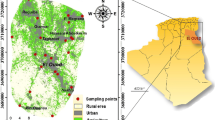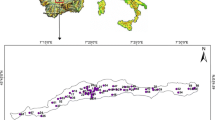Abstract
In an attempt to determine their suitability for consumption and irrigation uses, the prevailing hydrogeochemical processes and quality of both surface and groundwaters in Ojoto province, southeastern Nigeria were studied. Classical scientific methods and indicators such as hydrogeochemistry, stoichiometry, water quality index (WQI), and multivariate statistical analyses were integrated to achieve the research objectives. pH results classified most of the waters as slightly acidic. The order of dominance of the major cations and anions is Na+ > Ca2+ > K+ > Mg2+ and SO42– > Cl– > NO3– > HCO3–, respectively. The dominant water type is Na–Ca–SO4, and the dominant water facies in the area is sodium sulphate (Na–SO4), constituting about 54% of the total samples. Several hydrogeochemical, stoichiometric, and multivariate statistical analyses revealed that both anthropogenic inputs and geogenic processes (such as precipitation, silicate weathering, oxidation, and ionic exchange) influence the chemistry and quality of the waters. WQI of the waters showed that only 17.86% of the analyzed samples are of good quality for drinking purposes, whereas the quality of 53.57, 17.86, and 10.71% of the samples is poor, very poor, and unfit for use, respectively. Various irrigation suitability assessments (including salinity hazard, sodium absorption ratio, sodium percentage, residual sodium carbonate, chloro-alkaline indices, magnesium hazard, Kelly’s ratio, permeability index, and potential salinity) conducted revealed that majority of the analyzed waters have poor irrigation quality.










Similar content being viewed by others
References
Ahamed AJ, Loganathan K, Jayakumar R (2015) Hydrochemical characteristics and quality assessment of groundwater in Amaravathi river basin of Karur district, Tamil Nadu, South India. Sustain Water Resour Manag 1:273–291
Akpoborie IA, Nfor BN, Etobro AAI, Odagwe S (2011) Aspects of the geology and groundwater conditions of Asaba, Nigeria. Arch Appl Sci Res 3(2):537–550
Annapoorna H, Janardhana MR (2015) Assessment of groundwater quality for drinking purpose in rural areas surrounding a defunct copper mine. Aquat Procedia 4:685–692
APHA (2005) Standard methods for the examination of water and wastewater, 21st edn. American Public Health Association, Washington DC
Arua I (1986) Paleoenvironment of Eocene deposits in the Afikpo syncline, southern Nigeria. J Afr Earth Sci 5:279–284
Arveti N, Sarma MRS, Aitkenhead-Peterson JA, Sunil K (2011) Flouride incidence in groundwater: a case study from Talupula, Andhra Pradesh, India. Environ Monit Assess 172:427–443
Avci H, Dokuz UE, Avci AS (2018) Hydrochemistry and groundwater quality in a semiarid calcareous area: an evaluation of major ion chemistry using a stoichiometric approach. Environ Monit Assess 190:641. https://doi.org/10.1007/s10661-018-7021-8
BIS (1991) Indian standard drinking water-specification, 1st rev. Bureau of Indian Standards, New Delhi
Chen T, Zhang H, Sun C, Li H, Gao Y (2018) Multivariate statistical approaches to identify the major factors governing groundwater quality. Appl Water Sci. https://doi.org/10.1007/s13201-018-0837-0
Davis SN, De Wiest RJM (1966) Hydrogeology. Wiley, New York
Doe NA, Windecker N (2005) Groundwater notes. SHALE 11:37–44
Doneen LD (1964) Notes on water quality in Agriculture. Published as a water science and engineering paper 4001. Department of Water Science and Engineering, University of California, Oakland
Egboka BCE (1993) The raging war. A Publication of Anambra State Government of Nigeria, Awka
Egbueri JC (2018) Assessment of the quality of groundwaters proximal to dumpsites in Awka and Nnewi metropolises: a comparative approach. Int J Energy Water Res. https://doi.org/10.1007/s42108-018-0004-1
Egbueri JC (2019) Water quality appraisal of selected farm provinces using integrated hydrogeochemical, multivariate statistical, and microbiological technique. Model Earth Syst Environ. https://doi.org/10.1007/s40808-019-00585-z
El Alfy M, Lashin A, Abdalla F, Al-Bassam A (2017) Assessing the hydrogeochemical processes affecting groundwater pollution in arid areas using an integration of geochemical equilibrium and multivariate statistical techniques. Environ Pollut 5:6. https://doi.org/10.1016/j.envpol.2017.05.052
Ezenwaji EE, Ezenweani ID (2018) Spatial analysis of groundwater quality in Warri Urban. Sustain Water Resour Manag, Nigeria. https://doi.org/10.1007/s40899-018-0264-2
Freeze RA, Cherry JA (1979) Groundwater. Prentice-Hall, Englewood Cliffs
Gibbs RJ (1970) Mechanisms controlling world water chemistry. Science 170:1088–1090
Gleick PH (1996) Water resources. In: Schneider SH (ed) Encyclopedia of climate and weather, vol 2. Oxford University Press, New York, pp 817–823
Isa NM, Aris AZ, Azmin WN, Sulaiman W (2012) Extent and severity of groundwater contamination based on hydrochemistry mechanism of sandy tropical coastal aquifer. Sci Total Environ 438:414–425
Iscen CF, Özgür E, Ilhan S et al (2008) Application of multivariate statistical techniques in the assessment of surface water quality in Uluabat Lake, Turkey. Environ Monit Assess 144(1–3):269–276
Kelly WP (1940) Permissible composition and concentration of irrigation water. Proc Am Soc Civ Eng 66:607–613
Khan N, Hussain ST, Saboor A (2013) Physiochemical investigation of the drinking water sources from Mardan Khyber Pakhtunkhwa, Pakistan. Int J Phys Sci 8(33):1661–1671
Kim K, Rajmohan N, Kim HJ, Kim SH, Hwang GS, Yun ST, Gu B, Cho MJ, Lee SH (2005) Evaluation of geochemical processes affecting groundwater chemistry based on mass balance approach: a case study in Namwon, Korea. Geochem J 39:357–369
Kogbe CA (1976) Paleographic history of Nigeria from Albian Times. In: Kogbe CA (ed) Geology of Nigeria. Elizabethan Publishers, Lagos
Kumar R, Singh S, Sharma RC (2018) Application of WQI for assessment of water quality of high altitude lake Dodi Tal, Garhwal Himalaya, India. Sustain Water Resources Management. https://doi.org/10.1007/s40899-018-0281-1
Langenegger O (1990) Groundwater quality in rural areas of western Africa. UNDP project INT/81/026:10
Li P, Wu J, Qian H (2013) Assessment of groundwater quality for irrigation purposes and identification of hydrogeochemical evolution mechanisms in Pengyang County, China. Environ Earth Sci 69:2211–2225
McGowan W (2000) Water processing: residential, commercial, light-industrial, 3rd edn. Water Quality Association, Lisle
Meybeck M (1987) Global chemical weathering of surficial rocks estimated from river dissolved leads. Am J Sci 287:401–428
Mgbenu CN, Egbueri JC (2019) The hydrogeochemical signatures, quality indices and health risk assessment of water resources in Umunya district, southeast Nigeria. Appl Water Sci 9:22. https://doi.org/10.1007/s13201-019-0900-5
Nagajyoti PC, Lee KD, Sreekanth TV (2010) Heavy metals, occurrence and toxicity for plants: a review. Environ Chem Lett 8:199–216
NIS (2007) Nigerian standard for drinking water quality. Niger Ind Stand 554:13–14
Noh H, Huh Y, Qin J, Ellis A (2009) Chemical weathering in the three rivers region of Eastern Tibet. Geochim Cosmochim Acta 73:1857–1877
Nriagu JO (1989) A global assessment of natural sources of atmospheric trace metals. Nature 338:47–49
Nwachukwu SO (1972) The tectonic evolution of the southern portion of the Benue Trough, Nigeria. Geol Mag 109:411–419
Nwajide CS (2013) Geology of Nigeria’s sedimentary basins. CSS Press, Lagos
Okoro EI, Egboka BCE, Onwuemesi AG (2010a) Evaluation of the aquifer characteristics of the Nanka Sand using hydrogeological method in combination with vertical electric sounding (VES). J Appl Sci Environ Manag 14(2):5–9
Okoro EI, Egboka BCE, Anike OL, Enekwechi EK (2010b) Evaluation of groundwater potentials in parts of the Escarpment area of southeastern Nigeria. Int J Geomat Geosci 1(3):544–551
Paliwal KV (1972) Irrigation with saline water. Monogram no. 2 (new series). IARI, New Delhi
Pawari MJ, Gawande S (2015) Groundwater pollution and its consequence. Int J Eng Res Gen Sci 3(4):773–776
Ravikumar P, Aneesul MM, Somashekar RK (2013) Water quality index to determine the surface water quality of Sankey Tank and Mallathahalli Lake, Bangalore Urban District, Karnataka, India. Appl Water Sci 3:247–261
Reddy AGS, Kumar KN (2010) Identification of the hydrogeochemical processes in groundwater using major ion chemistry: a case study of Penna-Chitravathi river basins in Southern India. Environ Monit Assess 170:365–382
Reyment RA (1965) Aspects of the geology of Nigeria: the stratigraphy of the cretaceous and cenozoic deposits. Ibadan University Press, Ibadan
Richards LA (1954) Diagnosis and improvement of saline alkali soils: agriculture. Handbook 60, US Department of Agriculutre, Washington DC
Sawyer GN, McCarthy DL (1967) Chemistry of sanitary engineers, 2nd edn. McGraw Hill, New York
Schock MR (1989) Understanding lead corrosion control strategies. J Am Water Works Assoc 81:88
Schock MR (1990) Causes of temporal variability of lead in domestic plumbing systems. Environ Monit Assess 15:59
Schoeller H (1977) Geochemistry of groundwater. In: Groundwater studies—an international guide for research and practice, Supplement No. 3 to Groundwater Studies. UNESCO Tech. Papers Hydrol., vol 7. UNESCO, Paris
Subramani T, Elongo L, Damodarasamy SR (2005) Groundwater quality and its suitability for drinking and agricultural use in Chithar River Basin, Tamil Nadu, India. Environ Geol 47:1099–1110. https://doi.org/10.1007/s00254-005-1243-0
Sylus KJ, Ramesh H (2018) Geo-statistical analysis of groundwater quality in an unconfined aquifer of Nethravathi and Gurpur river confluence. Model Earth Syst Environ, India. https://doi.org/10.1007/s40808-018-0488-z
Tiwari TN, Mishra M (1985) A preliminary assignment of WQI to major Indian rivers. Indian J Environ Prot 5(4):276–279
WHO (2011) Hardness in Drinking-water: background document for development of WHO guidelines for drinking-water quality. World Health Organization, Geneva
WHO (2017) Guidelines for drinking water quality, 3rd edn. World Health Organization, Geneva
Wilcox LV (1955) Classification and use of irrigation water. USDA Circular 969, Washington DC
Zaidi FK, Nazzal Y, Jafri MK, Naeem M, Ahmed I (2015) Reverse ion exchange as a major process controlling the groundwater chemistry in an arid environment: a case study from northwestern Saudi Arabia. Environ Monit Assess 187:607. https://doi.org/10.1007/s10661-015-4828-4
Zhu B, Wang Y (2016) Statistical study to identify the key factors governing ground water recharge in the watersheds of the arid Central Asia. Environ Monit Assess 188:66. https://doi.org/10.1007/s10661-015-5075-4
Author information
Authors and Affiliations
Corresponding author
Additional information
Publisher's Note
Springer Nature remains neutral with regard to jurisdictional claims in published maps and institutional affiliations.
Rights and permissions
About this article
Cite this article
Egbueri, J.C., Mgbenu, C.N. & Chukwu, C.N. Investigating the hydrogeochemical processes and quality of water resources in Ojoto and environs using integrated classical methods. Model. Earth Syst. Environ. 5, 1443–1461 (2019). https://doi.org/10.1007/s40808-019-00613-y
Received:
Accepted:
Published:
Issue Date:
DOI: https://doi.org/10.1007/s40808-019-00613-y




